The Cambridge History of China. Vol. 13: Republican China 1912-1949, Part 2
Подождите немного. Документ загружается.

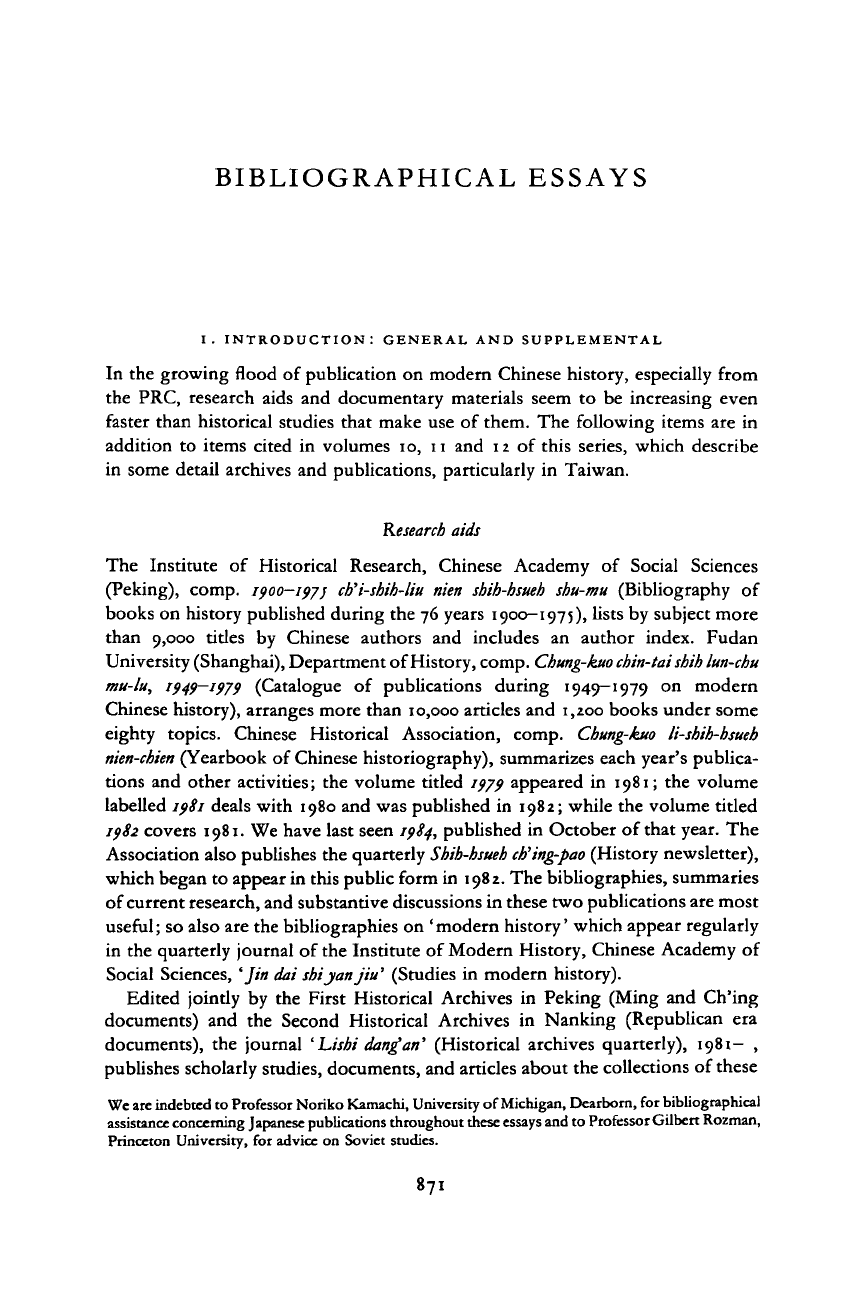
BIBLIOGRAPHICAL ESSAYS
i. INTRODUCTION: GENERAL AND SUPPLEMENTAL
In the growing flood
of
publication
on
modern Chinese history, especially from
the PRC, research aids
and
documentary materials seem
to be
increasing even
faster than historical studies that make use
of
them. The following items are
in
addition
to
items cited
in
volumes
10,
n
and
12
of
this series, which describe
in some detail archives and publications, particularly
in
Taiwan.
Research
aids
The Institute
of
Historical Research, Chinese Academy
of
Social Sciences
(Peking), comp. 1900-197; ch'i-shih-liu nien shih-hsueh shu-mu (Bibliography
of
books on history published during the 76 years 1900-1975), lists by subject more
than 9,000 titles
by
Chinese authors
and
includes
an
author index. Fudan
University (Shanghai), Department of History, comp.
Chung-kuo
chin-tai
shib lun-chu
mu-lu,
1949—1979
(Catalogue
of
publications during 1949-1979
on
modern
Chinese history), arranges more than 10,000 articles and 1,200 books under some
eighty topics. Chinese Historical Association, comp.
Chung-kuo li-shih-hsueh
nien-chien
(Yearbook
of
Chinese historiography), summarizes each year's publica-
tions and other activities; the volume titled
1979
appeared
in
1981;
the
volume
labelled
1981
deals with 1980 and was published
in
1982; while the volume titled
1982
covers 1981. We have last seen
19S4,
published
in
October of that year. The
Association also publishes the quarterly
Shih-hsueh ch'ing-pao
(History newsletter),
which began to appear in this public form in 1982. The bibliographies, summaries
of current research, and substantive discussions in these two publications are most
useful; so also are the bibliographies on 'modern history' which appear regularly
in the quarterly journal
of
the Institute
of
Modern History, Chinese Academy
of
Social Sciences, 'Jin
dai
shijanjiu' (Studies
in
modern history).
Edited jointly
by the
First Historical Archives
in
Peking (Ming
and
Ch'ing
documents)
and the
Second Historical Archives
in
Nanking (Republican
era
documents),
the
journal 'Lishi
dang'an'
(Historical archives quarterly), 1981-
,
publishes scholarly studies, documents, and articles about the collections of these
We are indebted to Professor Noriko Kamachi, University of Michigan, Dearborn, for bibliographical
assistance concerning Japanese publications throughout these
essays
and to Professor Gilbert Rozman,
Princeton University,
for
advice
on
Soviet studies.
871
Cambridge Histories Online © Cambridge University Press, 2008
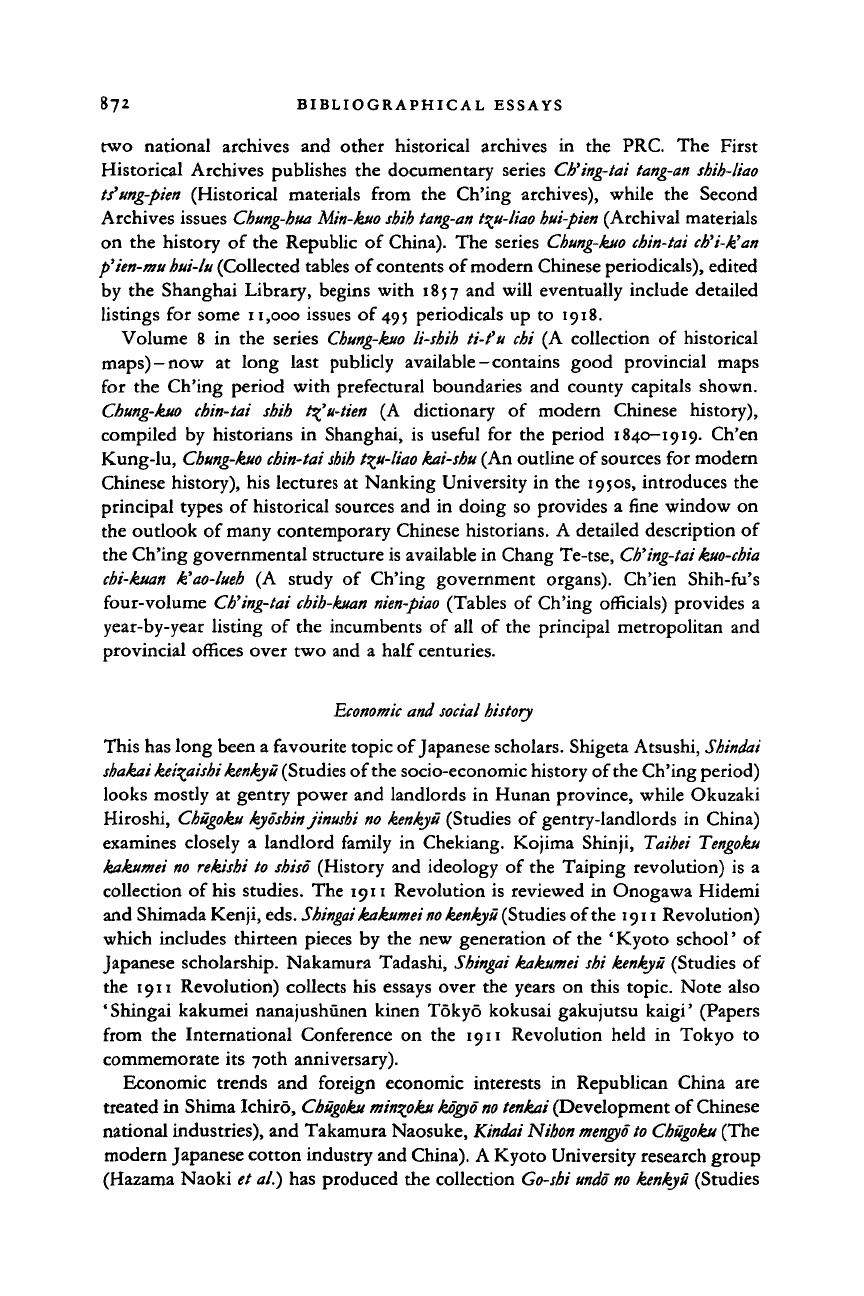
872 BIBLIOGRAPHICAL ESSAYS
two national archives and other historical archives in the PRC. The First
Historical Archives publishes the documentary series
Ch'ing-tai tang-an shih-liao
tfung-pien (Historical materials from the Ch'ing archives), while the Second
Archives issues
Chung-hua Min-kuo shih tang-an
t%u-liao
hui-pien
(Archival materials
on the history of the Republic of China). The series
Chung-kuo chin-tai
ch'i-k'an
p'ien-mu
hui-lu
(Collected tables of contents of modern Chinese periodicals), edited
by the Shanghai Library, begins with 1857 and will eventually include detailed
listings for some 11,000 issues of
495
periodicals up to 1918.
Volume 8 in the series
Chung-kuo
li-shih ti-Cu chi (A collection of historical
maps)-now at long last publicly available - contains good provincial maps
for the Ch'ing period with prefectural boundaries and county capitals shown.
Chung-kuo chin-tai shih tt£u-tien (A dictionary of modern Chinese history),
compiled by historians in Shanghai, is useful for the period 1840-1919. Ch'en
Kung-lu,
Chung-kuo chin-tai shih
t^u-liao
kai-shu
(An outline of sources for modern
Chinese history), his lectures at Nanking University in the 1950s, introduces the
principal types of historical sources and in doing so provides a fine window on
the outlook of many contemporary Chinese historians. A detailed description of
the Ch'ing governmental structure is available in Chang Te-tse,
Ch'ing-tai kuo-chia
chi-kuan k'ao-lueh (A study of Ch'ing government organs). Ch'ien Shih-fu's
four-volume
Ch'ing-tai chih-kuan nien-piao
(Tables of Ch'ing officials) provides a
year-by-year listing of the incumbents of all of the principal metropolitan and
provincial offices over two and a half centuries.
Economic
and
social
history
This has long been a favourite topic of Japanese scholars. Shigeta Atsushi,
Shindai
shakai keivytishi kenkyu
(Studies of the socio-economic history of the Ch'ing period)
looks mostly at gentry power and landlords in Hunan province, while Okuzaki
Hiroshi,
Chugoku
kyoshin jinushi
no
kenkyu (Studies of gentry-landlords in China)
examines closely a landlord family in Chekiang. Kojima Shinji, Taihei
Tengoku
kakumei
no
rekishi to
shiso
(History and ideology of the Taiping revolution) is a
collection of his studies. The 1911 Revolution is reviewed in Onogawa Hidemi
and Shimada Ken
ji,
eds. Shingai
kakumei no kenkyu
(Studies of the 1911 Revolution)
which includes thirteen pieces by the new generation of the ' Kyoto school' of
Japanese scholarship. Nakamura Tadashi,
Shingai
kakumei shi kenkyu (Studies of
the 1911 Revolution) collects his essays over the years on this topic. Note also
'Shingai kakumei nanajushunen kinen Tokyo kokusai gakujutsu kaigi' (Papers
from the International Conference on the 1911 Revolution held in Tokyo to
commemorate its 70th anniversary).
Economic trends and foreign economic interests in Republican China are
treated in Shima Ichiro,
Chugoku min^pku kogyo no tenkai
(Development of Chinese
national industries), and Takamura Naosuke,
Kindai Nihon mengyo to Chugoku
(The
modern Japanese cotton industry and China). A Kyoto University research group
(Hazama Naoki et al.) has produced the collection
Go-shi undo no kenkyii
(Studies
Cambridge Histories Online © Cambridge University Press, 2008
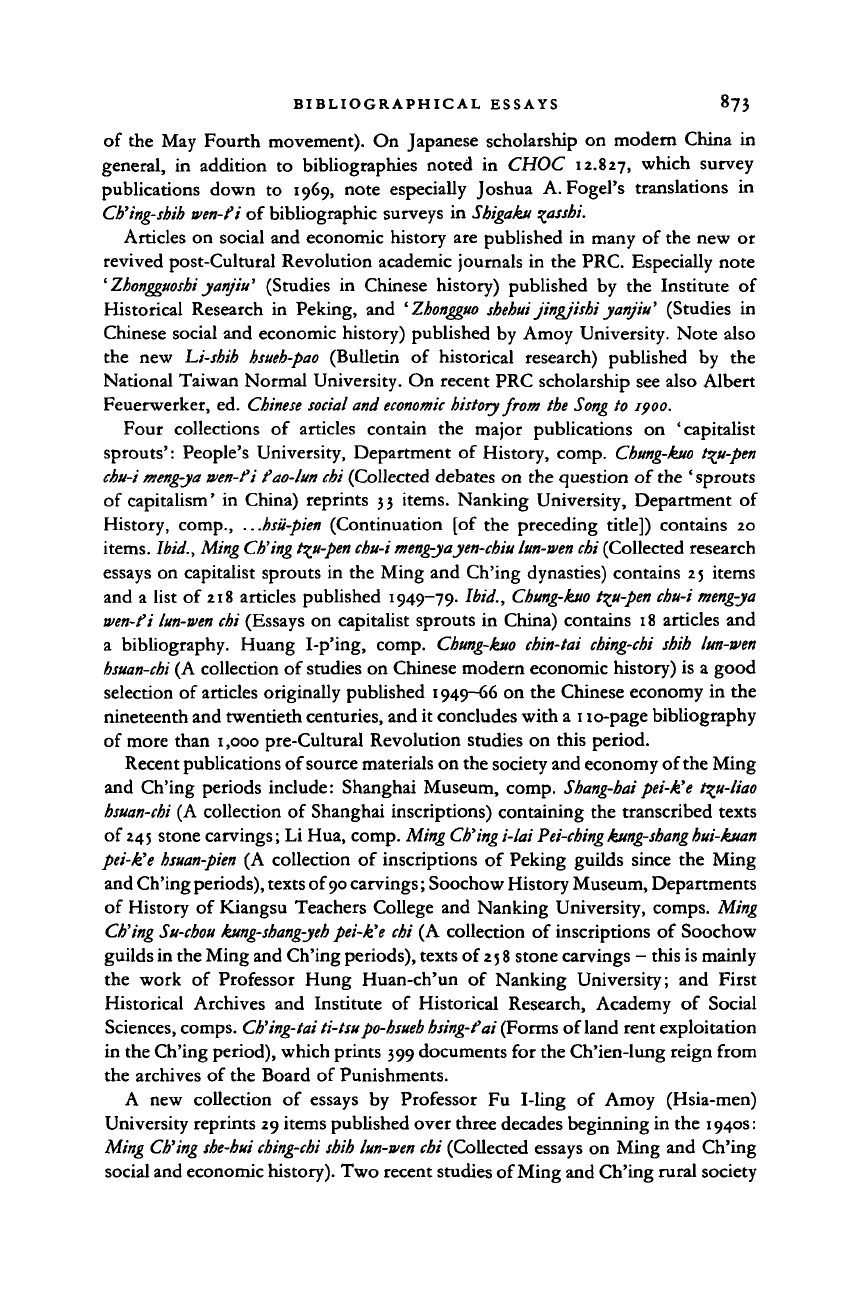
BIBLIOGRAPHICAL ESSAYS 873
of the May Fourth movement). On Japanese scholarship on modern China in
general, in addition to bibliographies noted in CHOC 12.827, which survey
publications down to 1969, note especially Joshua A. Fogel's translations in
Cb'ing-sbib
wen-fi of bibliographic surveys in
Shigaku
%assbi.
Articles on social and economic history are published in many of the new or
revived post-Cultural Revolution academic journals in the PRC. Especially note
'
Zhongguoshi
yanjiu' (Studies in Chinese history) published by the Institute of
Historical Research in Peking, and
'Zbongguo
shehui jingjisbiyanjiu' (Studies in
Chinese social and economic history) published by Amoy University. Note also
the new Li-shih
hsueh-pao
(Bulletin of historical research) published by the
National Taiwan Normal University. On recent PRC scholarship see also Albert
Feuerwerker, ed.
Chinese social
and
economic
history from the Song to 1900.
Four collections of articles contain the major publications on 'capitalist
sprouts': People's University, Department of History, comp.
Chung-kuo
t^u-pen
chu-i meng-ya
wen-fi fao-lun
chi
(Collected debates on the question of the ' sprouts
of capitalism' in China) reprints 33 items. Nanking University, Department of
History, comp
hsii-pien
(Continuation [of the preceding title]) contains 20
items.
Ibid.,
Ming Ch'ing
t^u-pen
chu-i meng-yayen-chiu lun-wen chi
(Collected research
essays on capitalist sprouts in the Ming and Ch'ing dynasties) contains 25 items
and a list of 218 articles published 1949-79.
Ibid.,
Chung-kuo
t^u-pen
chu-i meng-ya
wen-fi
lun-wen chi
(Essays on capitalist sprouts in China) contains 18 articles and
a bibliography. Huang I-p'ing, comp.
Chung-kuo
chin-tai
cbing-chi
shih
lun-wen
hsuan-chi
(A collection of studies on Chinese modern economic history) is a good
selection of articles originally published 1949-66 on the Chinese economy in the
nineteenth and twentieth centuries, and it concludes with a 110-page bibliography
of more than 1,000 pre-Cultural Revolution studies on this period.
Recent publications of source materials on the society and economy of the Ming
and Ch'ing periods include: Shanghai Museum, comp.
Shang-haipei-k'e
t^u-liao
hsuan-chi
(A collection of Shanghai inscriptions) containing the transcribed texts
of
245
stone carvings; Li Hua, comp.
Ming Ch'ing
i-lai
Pei-cbingkung-shanghui-kuan
pei-k'e
bsuan-pien
(A collection of inscriptions of Peking guilds since the Ming
and Ch'ing
periods),
texts of
90
carvings;
Soochow History Museum, Departments
of History of Kiangsu Teachers College and Nanking University, comps. Ming
Ch'ing Su-chou kung-shang-yeh
pei-k'e
chi
(A collection of inscriptions of Soochow
guilds in the Ming and Ch'ing periods), texts of
2 5 8
stone carvings - this is mainly
the work of Professor Hung Huan-ch'un of Nanking University; and First
Historical Archives and Institute of Historical Research, Academy of Social
Sciences, comps.
Cb'ing-tai ti-tsupo-hsueh hsing-fai
(Forms of land rent exploitation
in the Ch'ing period), which prints 399 documents for the Ch'ien-lung reign from
the archives of the Board of Punishments.
A new collection of essays by Professor Fu I-ling of Amoy (Hsia-men)
University reprints 29 items published over three decades beginning in the 1940s:
Ming
Ch'ing she-hui ching-cbi shih lun-wen chi
(Collected essays on Ming and Ch'ing
social and economic history). Two recent studies of Ming and Ch'ing rural society
Cambridge Histories Online © Cambridge University Press, 2008
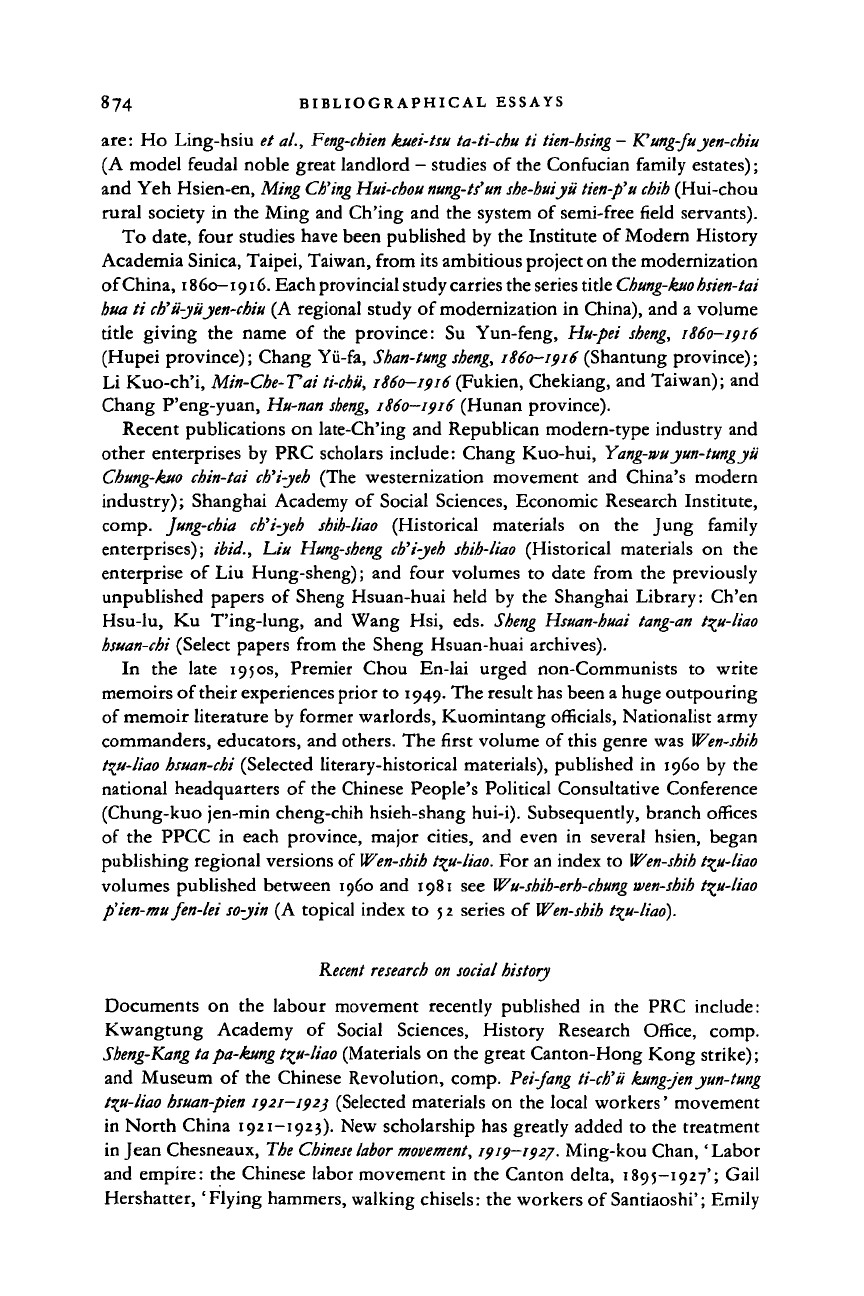
874 BIBLIOGRAPHICAL ESSAYS
are:
Ho Ling-hsiu et al.,
Feng-chien
kuei-tsu ta-ti-chu ti tien-hsing- K''ung-fuyen-chiu
(A model feudal noble great landlord - studies of the Confucian family estates);
and Yeh Hsien-en,
Ming Ch'ing Hui-chou nung-ts'un she-huiyii tien-p'u chih
(Hui-chou
rural society in the Ming and Ch'ing and the system of semi-free field servants).
To date, four studies have been published by the Institute of Modern History
Academia Sinica, Taipei, Taiwan, from its ambitious project on the modernization
of China, 1860-1916. Each provincial study carries the series title
Chung-kuo hsien-tai
bua
ti
cti'u-yiiyen-chiu
(A regional study of modernization in China), and a volume
title giving the name of the province: Su Yun-feng, Hu-pei
sheng,
1860—1916
(Hupei province); Chang Yii-fa,
Sban-tung
sheng,
1860-1916
(Shantung province);
Li Kuo-ch'i, Min-Cbe-Vai
ti-chii,
1860-1916
(Fukien, Chekiang, and Taiwan); and
Chang P'eng-yuan,
Hu-nan
sheng,
1860—1916
(Hunan province).
Recent publications on late-Ch'ing and Republican modern-type industry and
other enterprises by PRC scholars include: Chang Kuo-hui, Yang-wu yun-tungyii
Chung-kuo
chin-tai
ch'i-yeh
(The westernization movement and China's modern
industry); Shanghai Academy of Social Sciences, Economic Research Institute,
comp.
Jung-chia ch'i-yeh shih-liao (Historical materials on the Jung family
enterprises);
ibid.,
Liu
Hung-sheng
ch'i-jeh
shih-liao
(Historical materials on the
enterprise of Liu Hung-sheng); and four volumes to date from the previously
unpublished papers of Sheng Hsuan-huai held by the Shanghai Library: Ch'en
Hsu-lu, Ku T'ing-lung, and Wang Hsi, eds.
Sheng Hsuan-huai tang-an
t^u-liao
hsuan-chi
(Select papers from the Sheng Hsuan-huai archives).
In the late 1950s, Premier Chou En-lai urged non-Communists to write
memoirs of their experiences prior to 1949. The result has been a huge outpouring
of memoir literature by former warlords, Kuomintang officials, Nationalist army
commanders, educators, and others. The first volume of this genre was
Wen-shih
t^u-liao
hsuan-chi
(Selected literary-historical materials), published in i960 by the
national headquarters of the Chinese People's Political Consultative Conference
(Chung-kuo jen-min cheng-chih hsieh-shang hui-i). Subsequently, branch offices
of the PPCC in each province, major cities, and even in several hsien, began
publishing regional versions of
Wen-shih
t^u-liao.
For an index to
Wen-shih
t^u-liao
volumes published between i960 and 1981 see
Wu-shih-erh-chung wen-shih
t^u-liao
p'ien-mu
fen-lei so-yin (A topical index to 52 series of Wen-shih t^u-liao).
Recent
research
on
social
history
Documents on the labour movement recently published in the PRC include:
Kwangtung Academy of Social Sciences, History Research Office, comp.
Sheng-Kang
tapa-kung
t^u-liao
(Materials on the great Canton-Hong Kong strike);
and Museum of the Chinese Revolution, comp.
Pei-fang ti-ch'ii
kung-jen yun-tung
t\u-liao
hsuan-pien 1921—192)
(Selected materials on the local workers' movement
in North China 1921-1923). New scholarship has greatly added to the treatment
in Jean Chesneaux,
The Chinese labor
movement,
1919—1927.
Ming-kou Chan,' Labor
and empire: the Chinese labor movement in the Canton delta, 1895-1927'; Gail
Hershatter, 'Flying hammers, walking chisels: the workers of Santiaoshi'; Emily
Cambridge Histories Online © Cambridge University Press, 2008
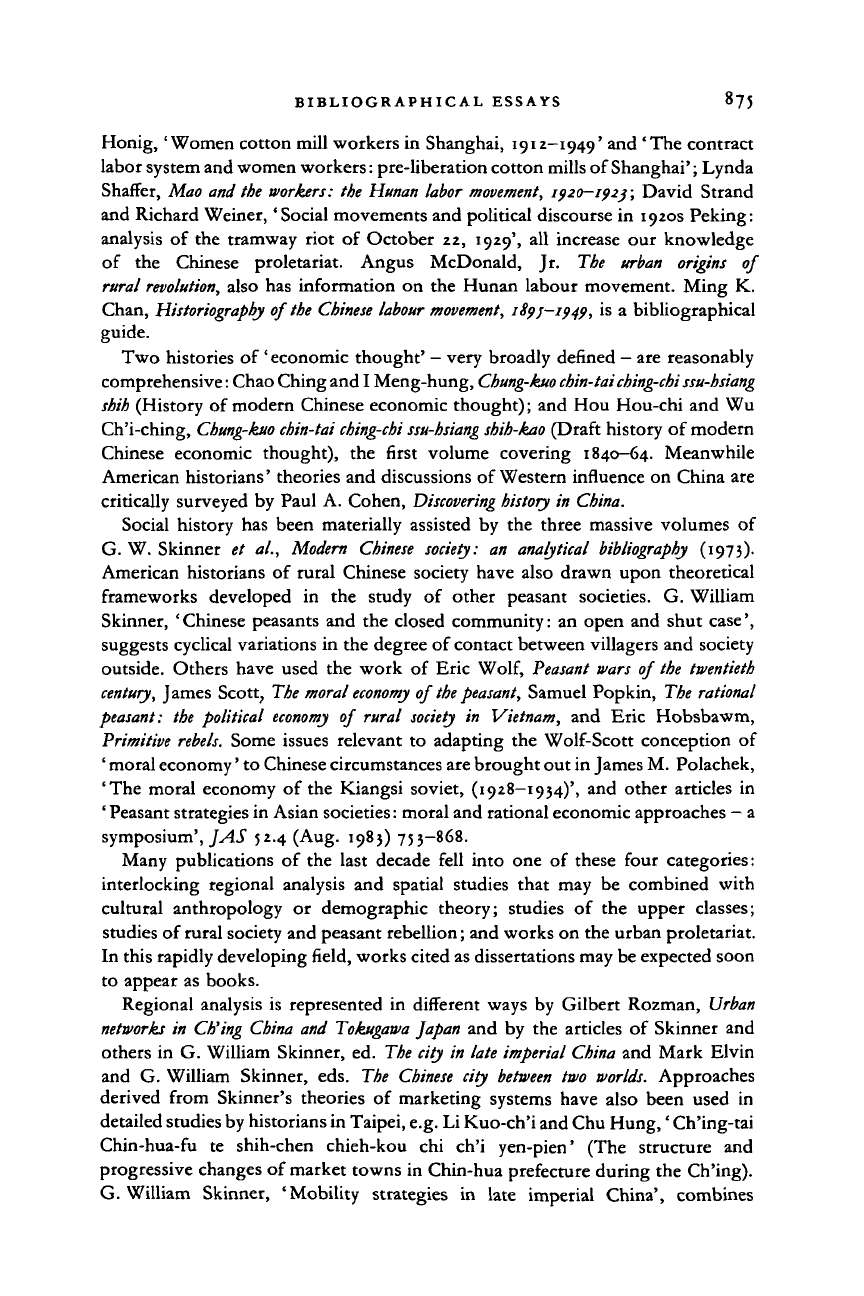
BIBLIOGRAPHICAL ESSAYS 875
Honig, 'Women cotton mill workers in Shanghai, 1912—1949' and 'The contract
labor system and women workers: pre-liberation cotton mills of Shanghai'; Lynda
Shaffer, Mao
and the
workers:
the
Hunan labor
movement,
1920-192);
David Strand
and Richard Weiner, 'Social movements and political discourse in 1920s Peking:
analysis of the tramway riot of October 22, 1929', all increase our knowledge
of the Chinese proletariat. Angus McDonald, Jr. The urban origins of
rural
revolution,
also has information on the Hunan labour movement. Ming K.
Chan,
Historiography
of
the Chinese labour
movement,
ifyj-1949, is a bibliographical
guide.
Two histories of
'
economic thought'
—
very broadly defined
—
are reasonably
comprehensive: Chao Ching and I Meng-hung,
Chung-kuo
cbin-tai ching-chi ssu-hsiang
shih
(History of modern Chinese economic thought); and Hou Hou-chi and Wu
Ch'i-ching,
Chung-kuo chin-tai ching-chi ssu-hsiang shih-kao
(Draft history of modern
Chinese economic thought), the first volume covering 1840-64. Meanwhile
American historians' theories and discussions of Western influence on China are
critically surveyed by Paul A. Cohen,
Discovering history
in China.
Social history has been materially assisted by the three massive volumes of
G. W. Skinner et al., Modern Chinese society: an analytical bibliography (1973).
American historians of rural Chinese society have also drawn upon theoretical
frameworks developed in the study of other peasant societies. G. William
Skinner, 'Chinese peasants and the closed community: an open and shut case',
suggests cyclical variations in the degree of contact between villagers and society
outside. Others have used the work of Eric
Wolf,
Peasant
wars of
the twentieth
century,
James Scott,
The moral economy
of
the
peasant,
Samuel Popkin, The
rational
peasant: the political
economy
of rural
society
in Vietnam, and Eric Hobsbawm,
Primitive
rebels.
Some issues relevant to adapting the Wolf-Scott conception of
' moral economy' to Chinese circumstances are brought out in James M. Polachek,
'The moral economy of the Kiangsi soviet, (1928—1934)', and other articles in
' Peasant strategies in Asian societies: moral and rational economic approaches - a
symposium', JAS 52.4 (Aug. 1983) 753-868.
Many publications of the last decade fell into one of these four categories:
interlocking regional analysis and spatial studies that may be combined with
cultural anthropology or demographic theory; studies of the upper classes;
studies of rural society and peasant rebellion; and works on the urban proletariat.
In this rapidly developing field, works cited as dissertations may be expected soon
to appear as books.
Regional analysis is represented in different ways by Gilbert Rozman, Urban
networks
in
Ch'ing China
and
Tokugawa
japan and by the articles of Skinner and
others in G. William Skinner, ed.
The city
in
late imperial China
and Mark Elvin
and G. William Skinner, eds. The
Chinese
city
between
two
worlds.
Approaches
derived from Skinner's theories of marketing systems have also been used in
detailed studies by historians in Taipei, e.g. Li Kuo-ch'i and Chu Hung,' Ch'ing-tai
Chin-hua-fu te shih-chen chieh-kou chi ch'i yen-pien' (The structure and
progressive changes of market towns in Chin-hua prefecture during the Ch'ing).
G. William Skinner, 'Mobility strategies in late imperial China', combines
Cambridge Histories Online © Cambridge University Press, 2008
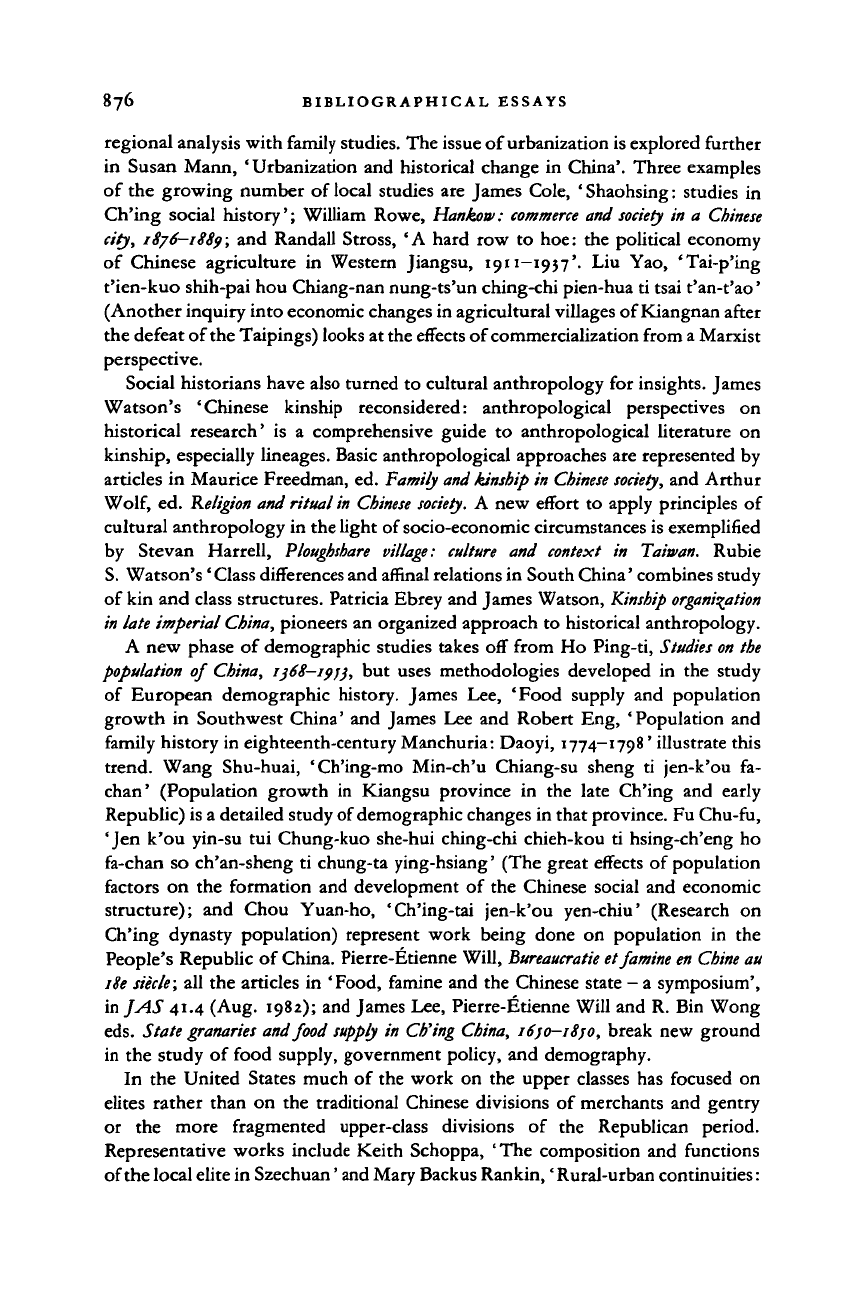
876 BIBLIOGRAPHICAL ESSAYS
regional analysis with family studies. The issue of urbanization is explored further
in Susan Mann, 'Urbanization and historical change in China'. Three examples
of the growing number of local studies are James Cole, 'Shaohsing: studies in
Ch'ing social history'; William Rowe, Hankow:
commerce and society
in a
Chinese
city,
1876—1889;
and Randall Stross, 'A hard row to hoe: the political economy
of Chinese agriculture in Western Jiangsu, 1911—1937'. Liu Yao, 'Tai-p'ing
t'ien-kuo shih-pai hou Chiang-nan nung-ts'un ching-chi pien-hua ti tsai t'an-t'ao'
(Another inquiry into economic changes in agricultural villages of Kiangnan after
the defeat of the Taipings) looks at the effects of commercialization from
a
Marxist
perspective.
Social historians have also turned to cultural anthropology for insights. James
Watson's 'Chinese kinship reconsidered: anthropological perspectives on
historical research' is a comprehensive guide to anthropological literature on
kinship, especially lineages. Basic anthropological approaches are represented by
articles in Maurice Freedman, ed.
Family and kinship
in
Chinese
society,
and Arthur
Wolf,
ed.
Religion and ritual in Chinese
society.
A new effort to apply principles of
cultural anthropology in the light of socio-economic circumstances is exemplified
by Stevan Harrell, Ploughshare village: culture and context in Taiwan. Rubie
S. Watson's' Class differences and affinal relations in South China' combines study
of kin and class structures. Patricia Ebrey and James Watson,
Kinship organisation
in late imperial
China,
pioneers an organized approach to historical anthropology.
A new phase of demographic studies takes off from Ho Ping-ti,
Studies on
the
population
of
China,
ij68—ipjj, but uses methodologies developed in the study
of European demographic history. James Lee, 'Food supply and population
growth in Southwest China' and James Lee and Robert Eng, 'Population and
family history in eighteenth-century Manchuria: Daoyi, 1774-1798' illustrate this
trend. Wang Shu-huai, 'Ch'ing-mo Min-ch'u Chiang-su sheng ti jen-k'ou fa-
chan' (Population growth in Kiangsu province in the late Ch'ing and early
Republic) is a detailed study of demographic changes in that province. Fu Chu-fu,
'Jen k'ou yin-su tui Chung-kuo she-hui ching-chi chieh-kou ti hsing-ch'eng ho
fa-chan so ch'an-sheng ti chung-ta ying-hsiang' (The great effects of population
factors on the formation and development of the Chinese social and economic
structure); and Chou Yuan-ho, 'Ch'ing-tai jen-k'ou yen-chiu* (Research on
Ch'ing dynasty population) represent work being done on population in the
People's Republic of China. Pierre-Etienne Will,
Bureaucratie
et famine
en Chine au
i8e
siecle;
all the articles in 'Food, famine and the Chinese state - a symposium',
in JAS 41.4 (Aug. 1982); and James Lee, Pierre-Etienne Will and R. Bin Wong
eds.
State
granaries
and food
supply
in
Ch'ing
China,
I6JO-I8JO, break new ground
in the study of food supply, government policy, and demography.
In the United States much of the work on the upper classes has focused on
elites rather than on the traditional Chinese divisions of merchants and gentry
or the more fragmented upper-class divisions of the Republican period.
Representative works include Keith Schoppa, 'The composition and functions
of the local elite in Szechuan' and Mary Backus Rankin,' Rural-urban continuities:
Cambridge Histories Online © Cambridge University Press, 2008
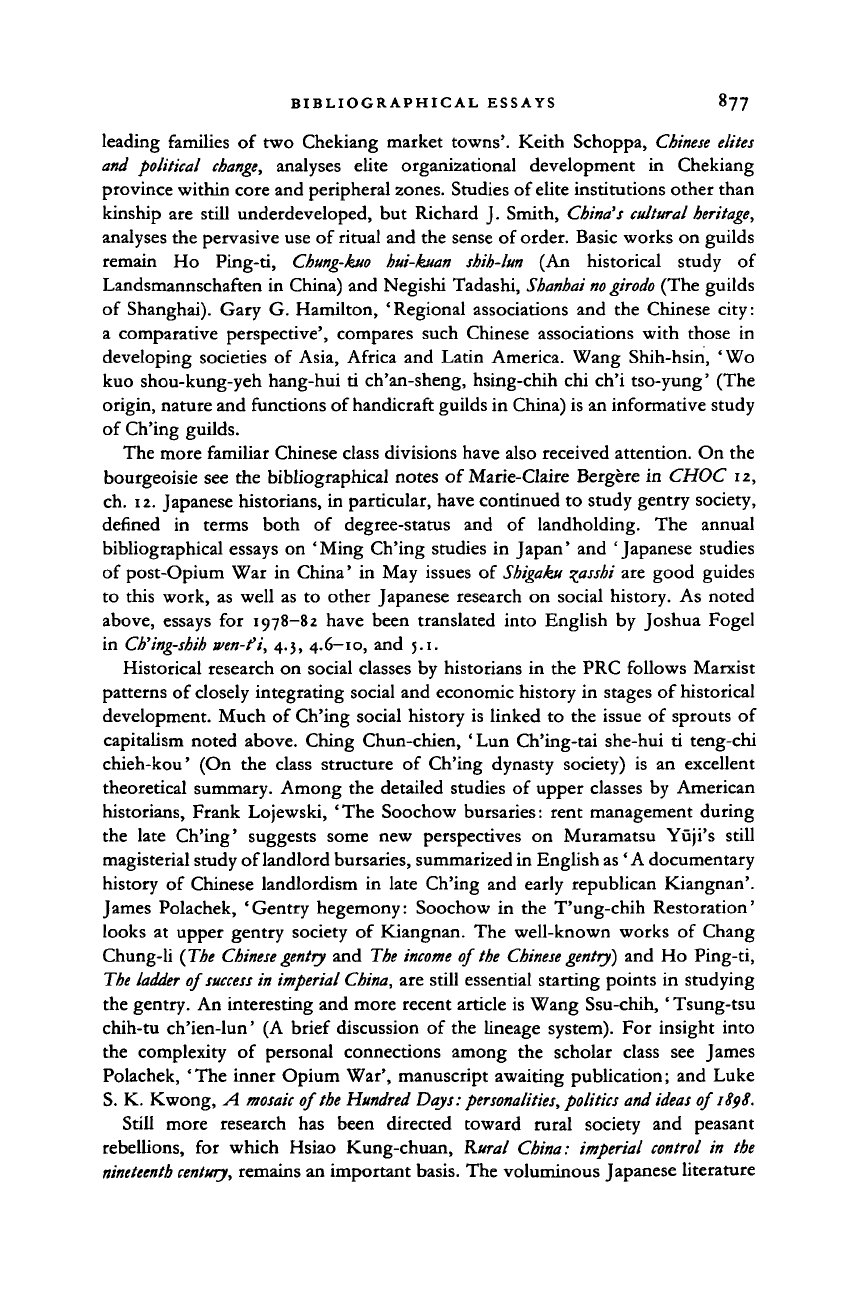
BIBLIOGRAPHICAL ESSAYS 877
leading families of two Chekiang market towns'. Keith Schoppa,
Chinese elites
and political
change,
analyses elite organizational development in Chekiang
province within core and peripheral zones. Studies of
elite
institutions other than
kinship are still underdeveloped, but Richard J. Smith,
China's cultural
heritage,
analyses the pervasive use of ritual and the sense of order. Basic works on guilds
remain Ho Ping-ti, Chung-kuo hui-kuan shih-lun (An historical study of
Landsmannschaften in China) and Negishi Tadashi,
Shanhai no girodo
(The guilds
of Shanghai). Gary G. Hamilton, ' Regional associations and the Chinese city:
a comparative perspective', compares such Chinese associations with those in
developing societies of Asia, Africa and Latin America. Wang Shih-hsin, ' Wo
kuo shou-kung-yeh hang-hui ti ch'an-sheng, hsing-chih chi ch'i tso-yung' (The
origin, nature and functions of handicraft guilds in China) is an informative study
of Ch'ing guilds.
The more familiar Chinese class divisions have also received attention. On the
bourgeoisie see the bibliographical notes of Marie-Claire Bergere in CHOC 12,
ch. 12. Japanese historians, in particular, have continued to study gentry society,
defined in terms both of degree-status and of landholding. The annual
bibliographical essays on 'Ming Ch'ing studies in Japan' and 'Japanese studies
of post-Opium War in China' in May issues of
Shigaku %asshi
are good guides
to this work, as well as to other Japanese research on social history. As noted
above, essays for 1978-82 have been translated into English by Joshua Fogel
in
Ch'ing-shih
wen-fi, 4.3, 4.6—10, and 5.1.
Historical research on social classes by historians in the PRC follows Marxist
patterns of closely integrating social and economic history in stages of historical
development. Much of Ch'ing social history is linked to the issue of sprouts of
capitalism noted above. Ching Chun-chien, 'Lun Ch'ing-tai she-hui ti teng-chi
chieh-kou' (On the class structure of Ch'ing dynasty society) is an excellent
theoretical summary. Among the detailed studies of upper classes by American
historians, Frank Lojewski, 'The Soochow bursaries: rent management during
the late Ch'ing' suggests some new perspectives on Muramatsu Yuji's still
magisterial study of landlord bursaries, summarized in English as '
A
documentary
history of Chinese landlordism in late Ch'ing and early republican Kiangnan'.
James Polachek, 'Gentry hegemony: Soochow in the T'ung-chih Restoration'
looks at upper gentry society of Kiangnan. The well-known works of Chang
Chung-li (The
Chinese gentry
and The
income
of
the Chinese gentry)
and Ho Ping-ti,
The ladder
of
success
in
imperial
China,
are still essential starting points in studying
the gentry. An interesting and more recent article is Wang Ssu-chih, ' Tsung-tsu
chih-tu ch'ien-lun' (A brief discussion of the lineage system). For insight into
the complexity of personal connections among the scholar class see James
Polachek, 'The inner Opium War', manuscript awaiting publication; and Luke
S. K. Kwong, A
mosaic
of
the
Hundred Days:
personalities,
politics and
ideas
of
1898.
Still more research has been directed toward rural society and peasant
rebellions, for which Hsiao Kung-chuan, Rural China: imperial
control
in the
nineteenth
century,
remains an important basis. The voluminous Japanese literature
Cambridge Histories Online © Cambridge University Press, 2008
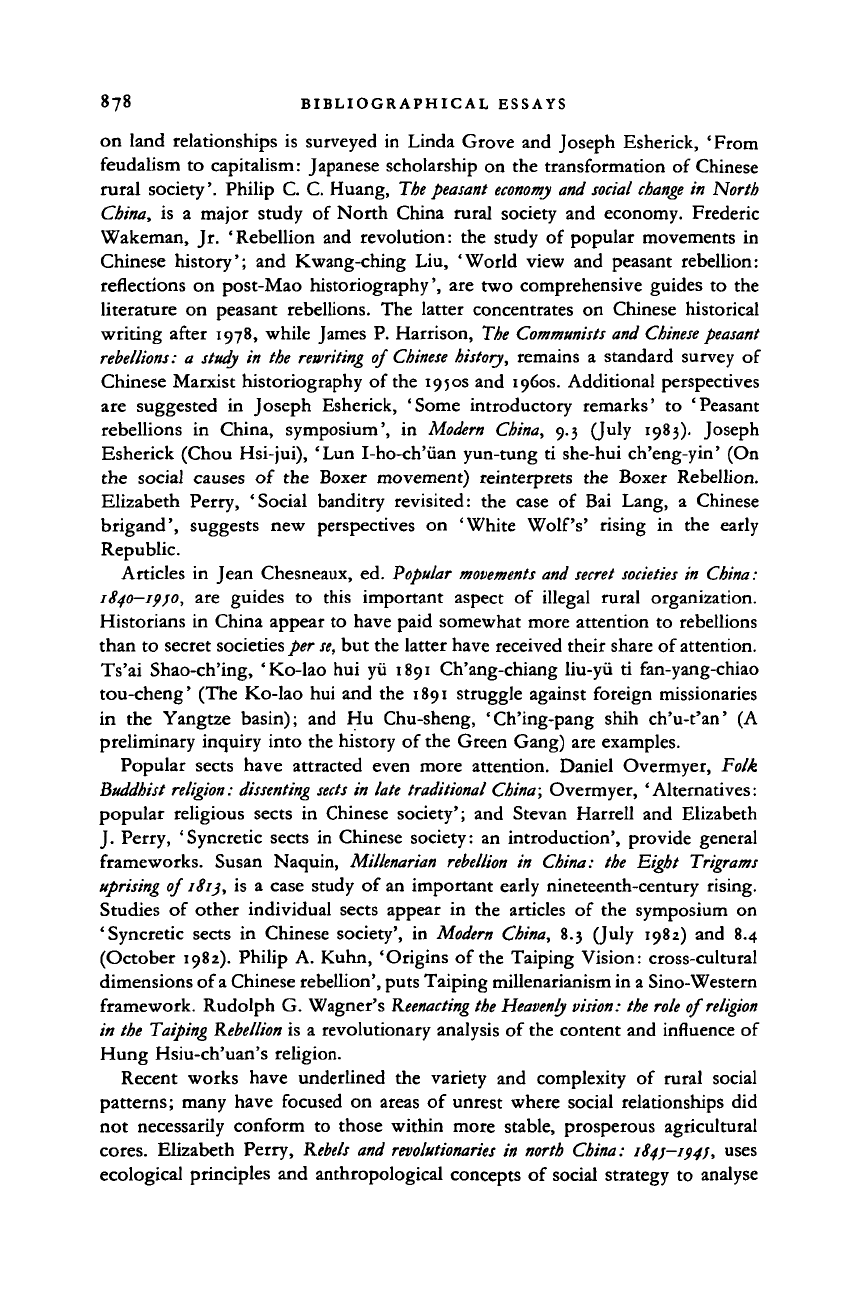
878 BIBLIOGRAPHICAL ESSAYS
on land relationships is surveyed in Linda Grove and Joseph Esherick, 'From
feudalism to capitalism: Japanese scholarship on the transformation of Chinese
rural society'. Philip C. C. Huang,
The peasant economy and social change
in North
China, is a major study of North China rural society and economy. Frederic
Wakeman, Jr. 'Rebellion and revolution: the study of popular movements in
Chinese history'; and Kwang-ching Liu, 'World view and peasant rebellion:
reflections on post-Mao historiography', are two comprehensive guides to the
literature on peasant rebellions. The latter concentrates on Chinese historical
writing after 1978, while James P. Harrison, The
Communists
and
Chinese peasant
rebellions:
a study in the
rewriting
of
Chinese
history,
remains a standard survey of
Chinese Marxist historiography of the 1950s and 1960s. Additional perspectives
are suggested in Joseph Esherick, 'Some introductory remarks' to 'Peasant
rebellions in China, symposium', in Modern China, 9.3 (July 1983). Joseph
Esherick (Chou Hsi-jui), 'Lun I-ho-ch'iian yun-tung ti she-hui ch'eng-yin' (On
the social causes of the Boxer movement) reinterprets the Boxer Rebellion.
Elizabeth Perry, 'Social banditry revisited: the case of Bai Lang, a Chinese
brigand', suggests new perspectives on 'White Wolf's' rising in the early
Republic.
Articles in Jean Chesneaux, ed. Popular movements and secret
societies
in China:
1840—ip/o,
are guides to this important aspect of illegal rural organization.
Historians in China appear to have paid somewhat more attention to rebellions
than to secret societies per
se,
but the latter have received their share of attention.
Ts'ai Shao-ch'ing, 'Ko-lao hui yii 1891 Ch'ang-chiang liu-yii ti fan-yang-chiao
tou-cheng' (The Ko-lao hui and the 1891 struggle against foreign missionaries
in the Yangtze basin); and Hu Chu-sheng, 'Ch'ing-pang shih ch'u-t'an' (A
preliminary inquiry into the history of the Green Gang) are examples.
Popular sects have attracted even more attention. Daniel Overmyer, Folk
Buddhist
religion:
dissenting sects
in
late traditional
China;
Overmyer, 'Alternatives:
popular religious sects in Chinese society'; and Stevan Harrell and Elizabeth
J. Perry, 'Syncretic sects in Chinese society: an introduction', provide general
frameworks. Susan Naquin,
Millenarian rebellion
in China: the Eight Trigrams
uprising
of
1813,
is a case study of an important early nineteenth-century rising.
Studies of other individual sects appear in the articles of the symposium on
'Syncretic sects in Chinese society', in Modern China, 8.3 (July 1982) and 8.4
(October 1982). Philip A. Kuhn, 'Origins of the Taiping Vision: cross-cultural
dimensions of a Chinese rebellion', puts Taiping millenarianism in a Sino-Western
framework. Rudolph G. Wagner's
Reenacting the Heavenly
vision:
the role
0/religion
in
the Taiping Rebellion
is a revolutionary analysis of the content and influence of
Hung Hsiu-ch'uan's religion.
Recent works have underlined the variety and complexity of rural social
patterns; many have focused on areas of unrest where social relationships did
not necessarily conform to those within more stable, prosperous agricultural
cores.
Elizabeth Perry,
Rebels
and
revolutionaries
in north China: 184^-194j, uses
ecological principles and anthropological concepts of social strategy to analyse
Cambridge Histories Online © Cambridge University Press, 2008
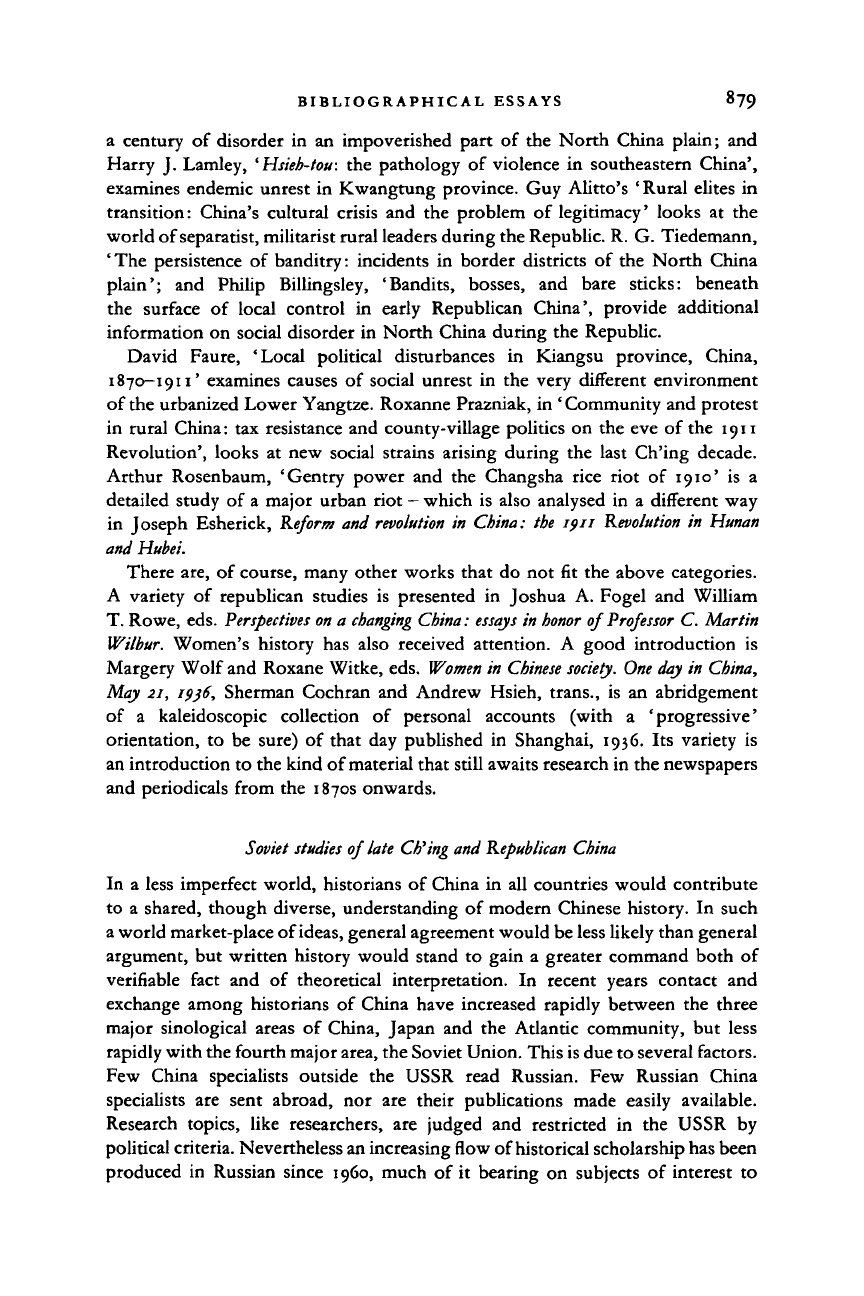
BIBLIOGRAPHICAL ESSAYS 879
a century of disorder in an impoverished part of the North China plain; and
Harry J. Lamley,
'Hsieh-tou:
the pathology of violence in southeastern China',
examines endemic unrest in Kwangtung province. Guy Alitto's 'Rural elites in
transition: China's cultural crisis and the problem of legitimacy' looks at the
world of separatist, militarist rural leaders during the Republic. R. G. Tiedemann,
'The persistence of banditry: incidents in border districts of the North China
plain'; and Philip Billingsley, 'Bandits, bosses, and bare sticks: beneath
the surface of local control in early Republican China', provide additional
information on social disorder in North China during the Republic.
David Faure, 'Local political disturbances in Kiangsu province, China,
1870-1911'
examines causes of social unrest in the very different environment
of the urbanized Lower Yangtze. Roxanne Prazniak, in ' Community and protest
in rural China: tax resistance and county-village politics on the eve of the 1911
Revolution', looks at new social strains arising during the last Ch'ing decade.
Arthur Rosenbaum, 'Gentry power and the Changsha rice riot of 1910' is a
detailed study of a major urban riot - which is also analysed in a different way
in Joseph Esherick, Reform and
revolution
in China: the
1911 Revolution
in Hunan
and
Hubei.
There are, of course, many other works that do not fit the above categories.
A variety of republican studies is presented in Joshua A. Fogel and William
T. Rowe, eds.
Perspectives
on a
changing
China:
essays
in
honor
of
Professor
C. Martin
Wilbur. Women's history has also received attention. A good introduction is
Margery Wolf and Roxane Witke, eds.
Women
in
Chinese
society.
One day
in China,
May 21,
1936,
Sherman Cochran and Andrew Hsieh, trans., is an abridgement
of a kaleidoscopic collection of personal accounts (with a 'progressive'
orientation, to be sure) of that day published in Shanghai, 1936. Its variety is
an introduction to the kind of material that still awaits research in the newspapers
and periodicals from the 1870s onwards.
Soviet studies of
late
Ch'ing and Republican China
In a less imperfect world, historians of China in all countries would contribute
to a shared, though diverse, understanding of modern Chinese history. In such
a world market-place of
ideas,
general agreement would be less likely than general
argument, but written history would stand to gain a greater command both of
verifiable fact and of theoretical interpretation. In recent years contact and
exchange among historians of China have increased rapidly between the three
major sinological areas of China, Japan and the Atlantic community, but less
rapidly with the fourth major area, the Soviet Union. This is due to several factors.
Few China specialists outside the USSR read Russian. Few Russian China
specialists are sent abroad, nor are their publications made easily available.
Research topics, like researchers, are judged and restricted in the USSR by
political criteria. Nevertheless an increasing flow of historical scholarship has been
produced in Russian since i960, much of it bearing on subjects of interest to
Cambridge Histories Online © Cambridge University Press, 2008
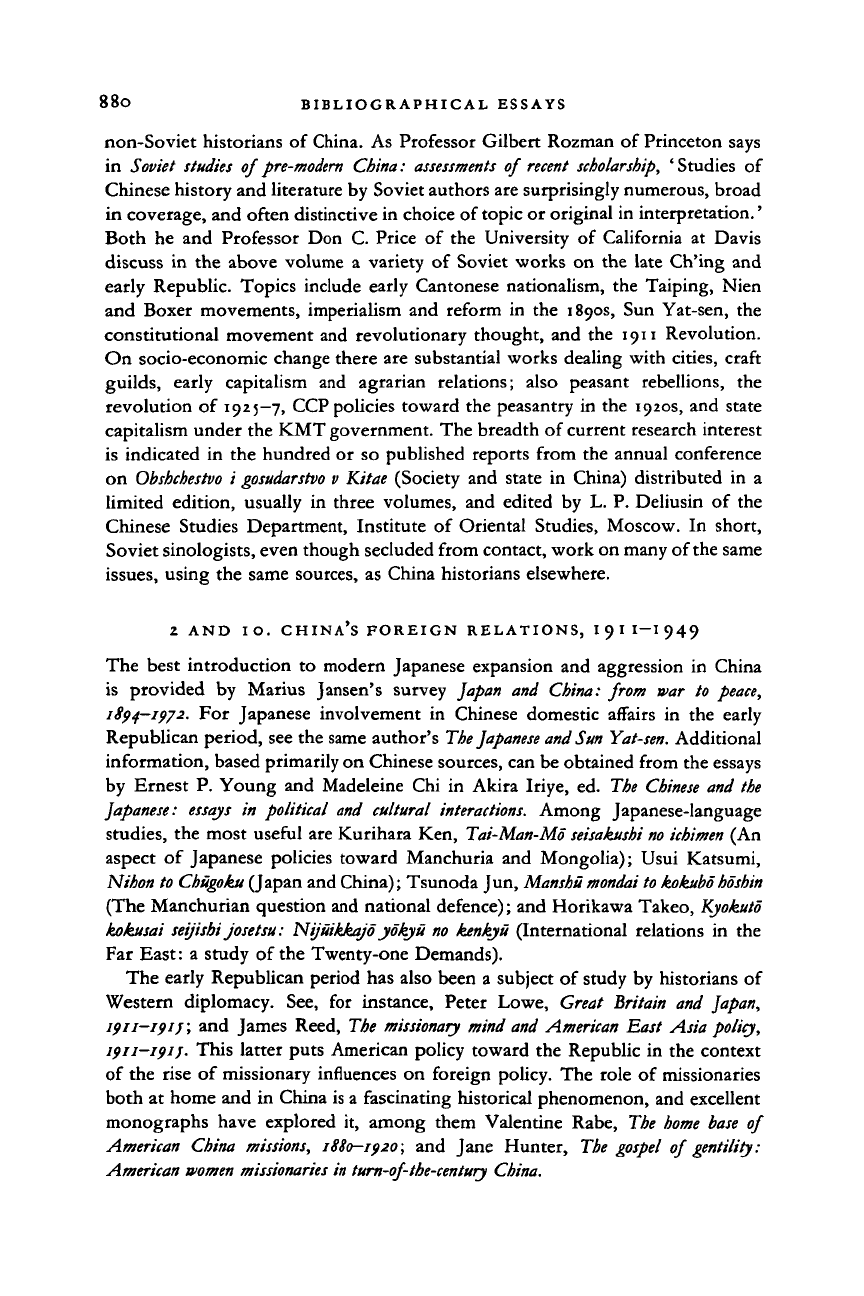
88O BIBLIOGRAPHICAL ESSAYS
non-Soviet historians
of
China.
As
Professor Gilbert Rozman
of
Princeton says
in Soviet studies
of
pre-modtrn China: assessments
of
recent scholarship,
'
Studies
of
Chinese history
and
literature
by
Soviet authors are surprisingly numerous, broad
in coverage,
and
often distinctive
in
choice
of
topic
or
original
in
interpretation.'
Both
he and
Professor
Don C.
Price
of the
University
of
California
at
Davis
discuss
in the
above volume
a
variety
of
Soviet works
on the
late Ch'ing
and
early Republic. Topics include early Cantonese nationalism,
the
Taiping, Nien
and Boxer movements, imperialism
and
reform
in the
1890s,
Sun
Yat-sen,
the
constitutional movement
and
revolutionary thought,
and the 1911
Revolution.
On socio-economic change there
are
substantial works dealing with cities, craft
guilds, early capitalism
and
agrarian relations; also peasant rebellions,
the
revolution
of
1925-7, CCP policies toward
the
peasantry
in the
1920s,
and
state
capitalism under
the
KMT government.
The
breadth
of
current research interest
is indicated
in the
hundred
or so
published reports from
the
annual conference
on
Obshchestvo
i
gosudarstvo
v
Kitae (Society
and
state
in
China) distributed
in a
limited edition, usually
in
three volumes,
and
edited
by L. P.
Deliusin
of the
Chinese Studies Department, Institute
of
Oriental Studies, Moscow.
In
short,
Soviet sinologists, even though secluded from contact, work
on
many
of
the same
issues, using
the
same sources,
as
China historians elsewhere.
2
AND IO.
CHINA'S FOREIGN RELATIONS,
191 I-I 949
The best introduction to modern Japanese expansion and aggression in China
is provided by Marius Jansen's survey Japan and China: from war to peace,
1894-1972. For Japanese involvement in Chinese domestic affairs in the early
Republican period, see the same author's
The
Japanese
and Sun
Yat-sen. Additional
information, based primarily on Chinese sources, can be obtained from the essays
by Ernest P. Young and Madeleine Chi in Akira Iriye, ed. The
Chinese
and the
Japanese: essays in political and cultural
interactions.
Among Japanese-language
studies,
the most useful are Kurihara Ken, Tai-Man-Mo
seisakushi no ichimen
(An
aspect of Japanese policies toward Manchuria and Mongolia); Usui Katsumi,
Nihon to
Chiigoku
(Japan and China); Tsunoda Jun,
Manshu mondai
to
kokubo hoshin
(The Manchurian question
and
national defence);
and
Horikawa Takeo,
Kyokuto
kokusai seijishi josetsu: Nijiiikkajo yokyu no kenkyii (International relations in the
Far East:
a
study
of
the Twenty-one Demands).
The early Republican period
has
also been
a
subject
of
study
by
historians
of
Western diplomacy.
See, for
instance, Peter Lowe, Great Britain and Japan,
1911-191;;
and James Reed, The
missionary
mind and American East Asia policy,
1911-191;.
This latter puts American policy toward
the
Republic
in the
context
of
the
rise
of
missionary influences
on
foreign policy.
The
role
of
missionaries
both
at
home
and in
China
is a
fascinating historical phenomenon,
and
excellent
monographs have explored
it,
among them Valentine Rabe,
The
home base
of
American China missions, 1880-1920; and Jane Hunter, The gospel of gentility:
American
women missionaries
in
turn-of-the-century
China.
Cambridge Histories Online © Cambridge University Press, 2008
